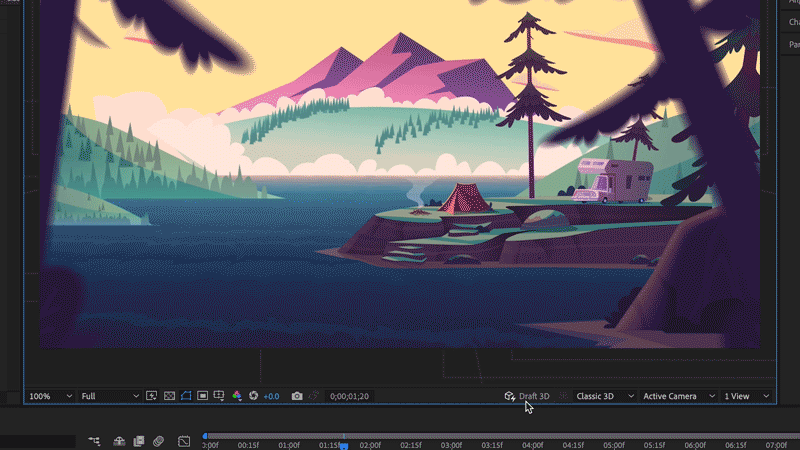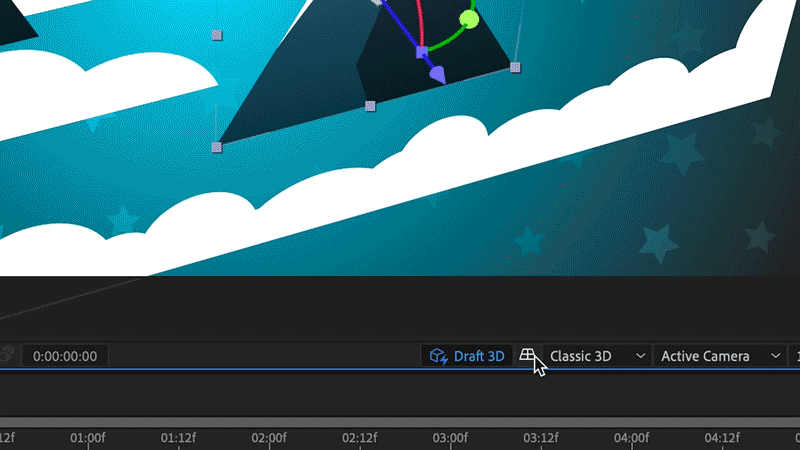When you have 3D content in your comp, the Draft 3D button appears in the Composition panel toolbar. Select the button to turn on Draft 3D Preview. What it does is that After Effects starts to use the Advanced 3D engine renderer to show you in real-time the changes or updates you make to your 3D design. This experience is seamless and faster, thus avoiding lag during the preview.
- After Effects User Guide
- Beta releases
- Getting started
- Workspaces
- Projects and compositions
- Importing footage
- Preparing and importing still images
- Importing from After Effects and Adobe Premiere Pro
- Importing and interpreting video and audio
- Preparing and importing 3D image files
- Importing and interpreting footage items
- Import SVG files
- Working with footage items
- Detect edit points using Scene Edit Detection
- XMP metadata
- Text and Graphics
- Text
- Motion Graphics
- Work with Motion Graphics templates in After Effects
- Use expressions to create drop-down lists in Motion Graphics templates
- Work with Essential Properties to create Motion Graphics templates
- Replace images and videos in Motion Graphics templates and Essential Properties
- Animate faster and easier using the Properties panel
- Variable Font Axes
- Drawing, Painting, and Paths
- Overview of shape layers, paths, and vector graphics
- Paint tools: Brush, Clone Stamp, and Eraser
- Taper shape strokes
- Shape attributes, paint operations, and path operations for shape layers
- Use Offset Paths shape effect to alter shapes
- Creating shapes
- Create masks
- Remove objects from your videos with the Content-Aware Fill panel
- Roto Brush and Refine Matte
- Create Nulls for Positional Properties and Paths
- Layers, Markers, and Camera
- Animation, Keyframes, Motion Tracking, and Keying
- Animation
- Keyframe
- Motion tracking
- Keying
- Transparency and Compositing
- Adjusting color
- Effects and Animation Presets
- Effects and animation presets overview
- Effect list
- Effect Manager
- Simulation effects
- Stylize effects
- Audio effects
- Distort effects
- Perspective effects
- Channel effects
- Generate effects
- Time effects
- Transition effects
- The Rolling Shutter Repair effect
- Blur and Sharpen effects
- 3D Channel effects
- Utility effects
- Matte effects
- Noise and Grain effects
- Detail-preserving Upscale effect
- Obsolete effects
- Cycore plugins
- Expressions and Automation
- Expressions
- Expression basics
- Understanding the expression language
- Using expression controls
- Syntax differences between the JavaScript and Legacy ExtendScript expression engines
- Editing expressions
- Expression errors
- Using the Expressions editor
- Use expressions to edit and access text properties
- Expression language reference
- Expression examples
- Automation
- Expressions
- Immersive video, VR, and 3D
- Construct VR environments in After Effects
- Apply immersive video effects
- Compositing tools for VR/360 videos
- Advanced 3D Renderer
- Import and add 3D models to your composition
- Import 3D models from Creative Cloud Libraries
- Create parametric meshes
- Image-Based Lighting
- Animated Environment Lights
- Enable lights to cast shadows
- Extract and animate lights and cameras from 3D models
- Tracking 3D camera movement
- Adjust Default Camera Settings for 3D compositions
- Cast and accept shadows
- Embedded 3D model animations
- Shadow Catcher
- 3D depth data extraction
- Modify materials properties of a 3D layer
- Apply Substance 3D materials
- Work in 3D Design Space
- 3D Transform Gizmos
- Single 3D Gizmo for multiple 3D layers
- Do more with 3D animation
- Preview changes to 3D designs real time with the Mercury 3D engine
- Add responsive design to your graphics
- Views and Previews
- Rendering and Exporting
- Basics of rendering and exporting
- H.264 Encoding in After Effects
- Export an After Effects project as an Adobe Premiere Pro project
- Converting movies
- Multi-frame rendering
- Automated rendering and network rendering
- Rendering and exporting still images and still-image sequences
- Using the GoPro CineForm codec in After Effects
- Working with other applications
- Collaboration: Frame.io, and Team Projects
- Memory, storage, performance
- Knowledge Base
Use the Draft 3D preview in After Effects, which uses the faster Advanced 3D renderer to preview your changes to your 3D scenes in real time.
Leverage the Draft 3D Preview that uses the faster Advanced 3D Engine renderer to preview your changes to your 3D scenes in real time. It's an engine that assists animation workflows by speeding up real-time playback in heavy scenes. The renderer runs on GPU. Unlike other renderers in After Effects, the Advanced 3D engine is only intended for draft quality and not the final output.
Learn more about working in 3D Design Animation Space.
Turn on Draft 3D Preview


-
-
Use any camera control such as dolly, orbit, and pan to view instant feedback for your designs.


A ground plane is a horizontal plane of projection that gives you a sense of perspective and space within your 3D scene. It visually orients a user in 3D space. It provides a reassuring grounding to a 3D space.
To use it, ensure that the Draft 3D button is enabled, and then switch on the 3D Ground Plane button next to it. This tool helps keep everything in your scene in perspective and proportion at a glance.
Important points
- The closer the objects are to the ground plane, the easier it's to understand their relationship to one another in 3D space.
- The ground plane grid progressively scales as you dolly in and out of the scene.
- The scene center locator axis is in the center of the comp view to give you a sense of the X, Y, and Z directions.
Use Extended Viewer to preview areas beyond composition boundaries
The Extended Viewer lets you view the 3D content outside the composition frame boundaries. Switch back to the standard frame view to view your composition’s final view.


When Draft 3D is enabled, some effects may not render on precompositions.
Do more with your 3D animations
Explore 3D animation settings and various capabilities to modify, edit, and enhance your 3D animations and 3D space.